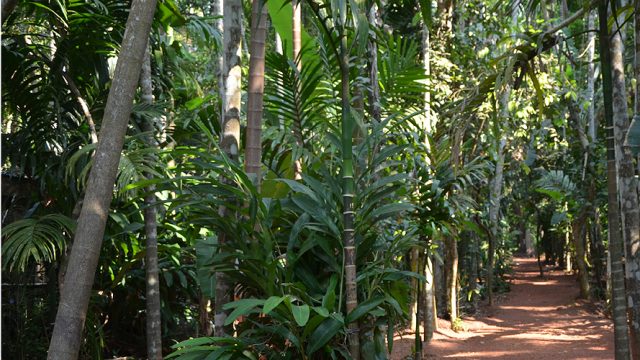An hour’s drive from from bustling Panjim is Ponda, an obscure pocket of greenery and winding roads. This little hamlet wasn’t on my itinerary, but when someone mentioned ‘spice plantation’ and ‘elephant ride’ together, I decided to check this place out. Through sheer serendipity I discovered the Tropical Spice Plantation of Ponda. As we approached, the scenery started to change before my eyes. Straight highways gave way to winding roads and houses and shops to forests. Suddenly I see this huge clearing in the middle of nowhere, a parking space with many scooters and small vehicles—well, Ponda and the spice plantation were not so obscure after all. I walked in and soon I was standing next to a bog, across which lay the Tropical Spice Plantation which looked like a private jungle of some sort. I’d stepped into a very different Goa: wreathed in silence, full of ducks, egrets and a couple of swans.

I crossed bouncy low-lying wooden foot-bridge gingerly and reached the entrance of the plantation. Following a welcoming ritual of a vermillion tika on the forehead and a thin garland of red hibiscus, I found myself in a large reception area where visitors were sitting on wooden benches, sipping some brew. Maybe nausea was written all over my face, because a kind usher came to me with a glass and a flask with some of that brew and told me to drink. I drank. I could taste lemongrass, ginger and cardamom. I was told that it was good for migraine. I had three more glasses.

It was already lunch time by the time I’d reached the plantation, so I was overjoyed to hear that, for Rs 400, I could eat from the buffet and also get a guided tour of the premises. I sat down for a meal of rice, fried fish, fried cabbage, chicken xacuti, papad and shrimp curry before taking the tour. The food was great by the way and I guess it was more fun because I ate on a plate made out of an areca nut leaf. There you go, eco-friendly lunch!
Now was the time for the spice tour. I joined a motley group of people of different nationalities and ages ranging from six to sixty. The plantation covers about a 100 acres of land. It grows everything from coriander to coffee (quite rare for Goa), and you’ll even find a 150-year- old coconut tree! We proceeded along the trails and came to a cottage (the owner’s) where they were selling bidis made out of banana leaf, much to the amusement of a French couple, who bought a couple of bundles. It was only after I came back to Delhi that I came to know that our humble bidis are pretty famous in the West.

I hail from the northeast and there were a lot of plants at the plantation that I recognised from my kitchen garden back home, and I was feeling pretty good. I walked along with a cheerful gait, but I did feel a little ashamed when I realised how little I knew about these plants, apart from their looks and smell. For instance, I noticed for the first time that the peri-peri chilli only grew in upward direction; and that bamboo grows 10 centimetres a day. I had no clue that the life of a betel nut tree is 45 years and that it yields fruits only twice a year between 15 and 25. Did you know that nutmeg in large quantities is highly toxic, while a pinch of it helps you sleep like a baby? Nor did I. Mace or tear gas is made of nutmeg flowers. The allspice plant, also known as Jamaican pepper, has a mixed aroma of cinnamon, cloves and nutmeg and it looks like pepper!
Did you know that cinnamon grows in only three countries? And that’s Indonesia, India and Sri Lanka. Goans use the cinnamon leaves instead of the bay leaf in their cuisine; that explains the signature aroma which I got in the local dishes while dining out in Goa. Did you also know that vanilla is hand-pollinated? Except in Madagascar, where hummingbirds help in pollination. Apart from all this, I was delighted to find out that the way to distinguish a female pineapple plant from a male one is to look at the leaves. The ones with spikes or thorns are of a female plant and the smooth ones that of a male.

The guide’s explanations were, from time to time, interrupted by screeching monkeys and insistent bird calls. The final attraction of the tour was a live demonstration of how to climb a betel nut tree. A very agile man tied a rope to his feet and raced to the top, jumped from one tree to another and slid back down—all under a minute! The demonstration was over before I’d even had a chance to process the blur of movement. In my defence, I was distracted by the sound of some people squealing with delight in the distance. All of us, hot and sweaty, were asked to queue up in front of our guide, who was standing with a ladle next to an earthen pot. The pot had vanilla-infused cold water which was poured on our back—a very cold and pleasant surprise! This, I realized, was the cause of all that squealing. The next time I visit, I will purchase that bundle of banana leaf bidi and will pay attention to the tree climber.
As I was exiting the plantation, my attention was drawn towards a group of visitors huddled outside an enclosure. I had to check. The enclosure turned out to be an elephant pen and people were getting ready to take a ride. I detested the idea of putting the gentle giant through the task of carrying people on its back, so I declined. Spice plantation yay; elephant ride certainly nay.




